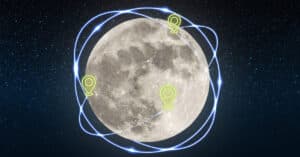Hundreds of exploration, commercialization, and scientific lunar missions are planned to launch in the coming years, and all of them will require a high-speed communication and navigation infrastructure to succeed. That’s one of the reasons why CREAN developed CelestNet – Internet for the Solar System.
What is CelestNet?
CelestNet is a constellation of satellites that provide data, voice, and video relay communication services as well as position, navigation, and timing (PNT) for missions on or near the lunar surface. This internet for the solar system will be high bandwidth, experiencing data rates of up to 200 Mbps. CelestNet will also have 24/7 earth day connectivity so that mission-critical data can be sent whenever it’s needed.
PNT will provide astronauts, scientists, and robots with location information so they can perform and document complex exploration missions. These missions will require precise maneuvering and the ability to plot significant sites, discoveries, and resources. Soon, detailed moon maps will emerge, created from data transmitted by CelestNet, furthering our lunar understanding and igniting the imagination of generations to come.
Who Can Benefit From CelestNet?
Hundreds of exploration, commercialization, and scientific lunar missions are planned in the near future by governments and companies from nearly every continent. Thanks to CelestNet’s advanced satellite communication capabilities, these missions can now be pursued with greater efficiency and reliability than ever before.
Artemis missions – It’s no secret that the US is going back to the moon to establish long-term residence. Dubbed the Artemis base camp, these lunar dwellings and exploration sites are being established with an eye toward sending the first astronauts to Mars.
The Artemis missions will need a reliable communication and navigation system to support the ambitious projects. The high-speed internet connection provided by CelestNet allows astronauts on the moon to send and receive mission data quickly while also providing them with up-to-date lunar maps for navigation.
NASA’s Near Space Network (NSN) Users – The NSN orchestrates communications services, space links, and data transports for commercial and government projects and initiatives. Once a project is accepted into the network, it can begin utilizing advanced communications technology in the near space region, out to two million kilometers from Earth’s surface. Partnerships within the network will provide organizations with an opportunity to collaborate, innovate, and thrive in the future.
National Defense Organizations – According to The Combined Space Operations Vision 2031 (CSpO), “space is integral to modern multi-domain military operations and provides strategic advantage. Space-based capabilities deliver a wide range of effects that underpin daily life, including communications, navigation, remote sensing, Earth observation, weather services, and financial transactions. Maintaining and supporting the availability of these capabilities are in the interest of each nation. Continued delivery of these capabilities requires complete access to and freedom to operate in space.”
Additional guiding principles include freedom of use of space – “Militaries have an important role in contributing to international efforts to ensure freedom of access to and use of space. CSpO Participants work to ensure our national security space operations promote a secure, stable, safe, peaceful, and operationally sustainable space domain.”
Embracing and building on this vision, NASA is building close partnerships with the Defense Department to include “human spaceflight, space policy, space transportation, standards and best practices for safe operations in space, scientific research, and planetary defense.” These partnerships will require complex and reliable communication channels between organizations and lunar or interstellar locations and vehicles.
International moon missions – Many countries are entering into moon exploration. Some countries began sending rovers in 2022 and several others are preparing for missions in 2023 and beyond. Encrypted data transmission and storage will enable these exploratory missions to securely share real-time information with scientists and engineers.
Commercial moon missions – Civilian moon missions are gaining momentum. NASA’s Commercial Lunar Payload Services (CLPS) program is an initiative designed to provide a reliable and cost-effective delivery service for small payloads to the lunar surface, enabling commercial entities to access lunar resources.
NASA, through its CLPS, has partnered with several private companies which are developing lunar landers to transport payloads. When these projects deploy, they will need to communicate and navigate with a high degree of accuracy.
How Does CelestNet Fit Into the Lunar Economy?
The lunar economy is an emerging market consisting of activities that involve the exploration, extraction, and utilization of resources found on or near the moon. This could include mining, energy production (solar, nuclear), manufacturing, tourism, agriculture, and space transportation. All these activities require an efficient communication infrastructure to ensure mission success.
CelestNet will give scientists, engineers, business owners, and entrepreneurs the ability to stay connected with their lunar operations at all times by utilizing the data transmitted through CelestNet satellites. This capability will enable data-driven decisions for lunar projects to be made quickly and accurately. With a powerful internet connection, it’s easy to envision how the lunar economy, and CelestNet, will grow rapidly.
Final Thoughts
CelestNet is poised to be the backbone of communication between Earth and the Moon, providing reliable high-speed Internet and navigation services for a variety of industries and missions. CelestNet will revolutionize lunar exploration, creating opportunities to push our understanding further than ever before and open up new economic possibilities in space. It’s also important to inspire future generations by enabling young people to communicate with astronauts like never before. A new generation of explorers will be born thanks to the connections made possible by CelestNet.
Click here for additional details.

